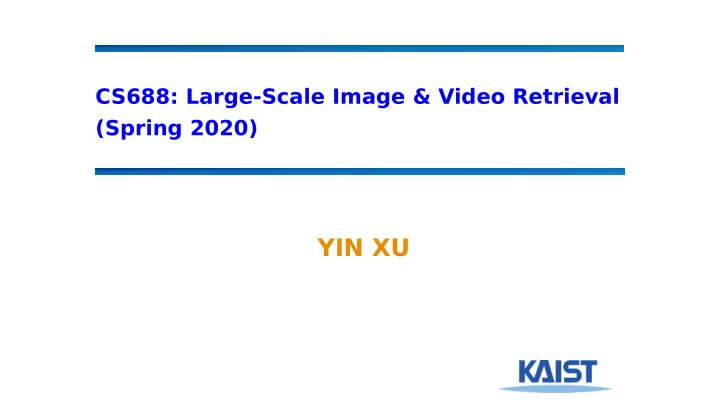

CS688: Large-Scale Image & Video Retrieval (Spring 2020) YIN XU
1. Image Segmentaion & Retrieval What is image segmentation? What’s the relationship to image retrieval? 2. Current challenges & solutions: Challenges: Intra-class inconsistency & Inter-class indistincition Solutions: point-based & countor-basede 3. PointRend:Image Segmentation as Rendering 4. Summary
What is semantic segmentation? Idea: recognizing, understanding what's in the image in pixel level. "T wo men riding on a bike in front of a building on the road. And there is a car." 5/12/2020 3
Why semantic segmentation? 1. Robot vision and understanding 2. Autonomous driving 3. Medial image analysis 5/12/2020 4
Interesting topics of segmentation: 1. 2D images: (general) sematic segmentation, instance segmentation 2. 3D images: Point clouds 3. Video segmentation 5/12/2020 5
Semantic segmentation: a process of assigning a label to every pixel in the image Instance segmentation: treat multiple objects of the same class as distinct individual objects (or instances) 5/12/2020 6
Segmentation-based Retrieval (mainly for object-based retrieval): 1. Avoiding large number of regions in one image ---- manageable regions / objects 2. Extracting simple boundary regions (avoiding disturbrance): ---- segmented regions can be a unit in retrieval 3. Make a robust datatset descriptor ---- reduce search space 5/12/2020 7
• Challenges: Intra-class Inconsistency: The same semantic label but different appearances Inter-class Indistinction: Different semantic labels but with similar appearances 5/12/2020 8
Deep Snake for Real-Time Instance Segmentation 5/12/2020 9
Deep Snake for Real-Time Instance Segmentation,CVPR 2020 5/12/2020 10
Steps: 1) compute the boundary map with given semantic labels. 2) For each pixel, find the closet pixel on the boundary. Efficient Segmentation: Learning Downsampling Near Semantic Boundaries, ICCV 2019 5/12/2020 11
upsampling +correction 12 5/12/2020
Coarse N*C*7*7 features Coarse prediction N*2*C*7*7 Iteratively cat Target size “renderrin g” N*C*7*7 input FG predictions From 7*7 to 224*224: 224 ---- �X 7 = 5 iterations 5/12/2020 13
Steps: 1) Upsample (Bilinear Interpolation) 2) Uncertainty calculation: --- the difference between the most & second most confidence --- set a threshold 0.5 3) Generate k*N points from uniform distribution and then select the top β ∗ N ones Notes: (uncertain). Correction: 3-layer MLP Last step of segmentation: 4) Feed selected pixels into 3-layer MLP ---map all vectors to a K-d space (with conv1*1) ---using argmax( � ) (pixel classification) ----use the indices as its classification 5/12/2020 14
N,K,2*W,2* N,K,2*W,2*H H N,K,W,H uncertaint y upsamle Sampling -0.5 selectio n Correction: 3-layer MLP 5/12/2020 15
When N = 28 ∗ 28 Sampling Steps: from 7*7 to 112*112 5/12/2020 16
Key-point Sampling Key-point Sampling segmentation 5/12/2020 17
Point Rend (Segementation) Point Rend: instance Instance Segmentation 5/12/2020 18
Point Rend (Segementation) Point Rend: instance 5/12/2020 19
5/12/2020 20
5/12/2020 21
Summary: Problem: inconsistent segmentation around edge regions Method: key-point detection + pixel-wise correction Components: 1) Sampling method: coarse prediction + uncertainty 2) Pixel correction : 3-layer MLP 3) Process: iteratively implement upsampling +correction Personal thinkings: Ads: 1) Fine-grained segmentation 2) edge preservation Dis: may not that useful in general semenatics. 5/12/2020 22
Q & A 5/12/2020 23 23
Recommend
More recommend